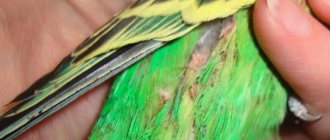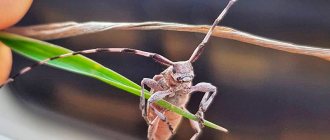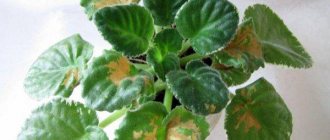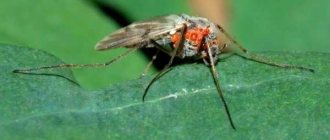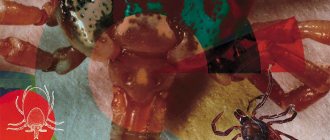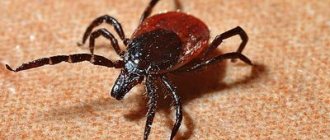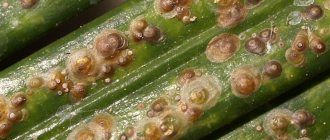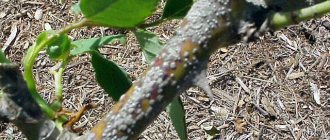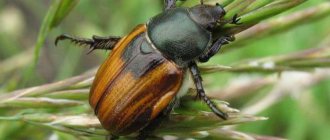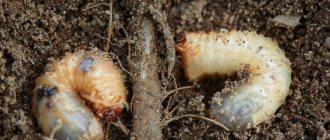Experienced flower growers know that orchid mites can appear on an orchid for various reasons. Among them are errors in the maintenance and care of tropical plants, as well as changes in temperature and humidity levels, and lack of nutrients. Folk remedies and special preparations help to cope with the pest.
Step-by-step instructions on how to get rid of various pests
Arachnoid
After detecting a spider mite on an orchid, you can get rid of it using several methods:
- Biological. It is enough to have several walls of predatory beetles that will destroy adult ticks.
- Chemical. Insecticidal preparations need to be alternated, as parasites develop immunity to the products used. In addition, a one-time treatment will not be enough; it will have to be carried out systematically. The following drugs are effective: Metaldehyde, Thiophos, Actellik.
- Folk. To combat spider mites, you can use a decoction of cyclamen roots. Pour water over the tubers, boil for 30 minutes, leave for 24 hours, and use the resulting filtered liquid to spray the orchid. Carry out treatment every 5 days 3-4 times. Simply wiping the orchid leaves with a cloth soaked in alcohol will help get rid of spider mites.
We invite you to watch a video on how to get rid of spider mites:
Bulbous
As soon as this pest is discovered, it is necessary to immediately change the soil in the pot. You can get rid of bulb mite in the following ways:
- Folk. Using folk remedies is effective only at the early stage of the infection, when the mites have not spread much. A solution of laundry soap is suitable (20 g of raw materials per 1 liter of water). You can use it to wipe orchids or immerse the flower completely in the solution. You can try spraying the plant with a weak solution of potassium permanganate.
- Chemical. Flower growers use general-spectrum insecticides.
But you can also use highly specialized drugs that will only fight ticks - these are acaricides. To prepare the solution, you need to use the instructions indicated on the package. The concentration can be made weaker, but not stronger, otherwise the opposite effect is possible. It is necessary to soak the flower in the prepared solution, and send the roots back into the soil only when they are completely dry.
Root
This parasite is the most difficult and tenacious to remove. It has a high ability to recover and reproduce. If a root mite is noticeable on the orchid, then all affected parts of the flower must be urgently removed, and the cut areas must be treated with activated carbon powder. Affected plants must be isolated from other healthy ones. Throw away the soil immediately and disinfect the pot.
Folk remedies suggest using a nettle decoction, which will not only eliminate pests, but also increase the flower’s immunity.
To prepare the solution, you need to: take 700 g of fresh herb, pour 5 liters of boiling water and leave for 30 minutes in a dark place.
How to treat a plant? This is done within 5 minutes, immersing the entire orchid in the broth. Of the chemical preparations, ascaricides remain effective. You can also use the insectoacaricidal agent Acaritox against pests. Use it strictly according to the instructions, and the frequency of treatment is every 5-7 days.
Biological products are also effective against root mites:
- Verticillin;
- Summer resident;
- Nematophagin.
Flat beetle
To quickly and effectively get rid of the parasite, it is better to immediately use chemicals - acaricides. Since mites are not insects, it is useless to use insecticides.
Most often used:
- Actofik;
- Fitoverm;
- Vermitek.
You can use folk remedies that were given earlier, but they are only effective at the early stage of infection.
Armored
This parasite lives underground, so you need to get rid of it as quickly as possible. To do this, the first step is to remove the flower from the soil and soak the root system in water for half an hour.
3-5 minutes after diving, you will see the parasites begin to emerge. After half an hour, remove the root system from the water and lay it down to dry. Carry out activities 2-3 times to get maximum results. When the roots are dry, you can transplant the plant into new soil. If you use chemical control methods, then acaricidal drugs are effective, including:
- Karbofos;
- Sumiton;
- Aktellik
In the store you can buy a predatory mite - Hypoasmis myles. One package will be enough to completely get rid of parasites.
From the video you can learn how to get rid of armored mites:
Differences between armored and spider mites
There are many types of oribatid mites; scientists count more than 6,000 species of these arthropods. Almost any of them can be seen on orchids, but the most common are the small, black, shiny, round mites. They mainly choose bark-based substrates as their habitat. The armored mite, unlike the arachnid arthropod, does not cause much harm to orchids; it is, as it were, its good neighbor. This species causes real harm when the colony reaches catastrophic numbers, which is extremely rare. The differences between these two types of ticks are summarized in the table.
| Arachnoid | Armored |
| Color: whitish, dirty gray, sand, light brown, yellowish with brown spots. The average size of adult individuals reaches .01-0.3 mm. | The color of the body is black or dark brown. Its dimensions range from 0.7 to 0.9 mm. Brown or reddish-tinged eggs can be seen with the naked eye. |
| Slow arthropods, capable of crawling 5 mm in 1-2 minutes. Most often they sit motionless. | Quite nimble pliers. In one second they are able to overcome 5-7 mm. |
| Despite the fact that spider mites are not afraid of light, they settle on the back side of sheets and are easily retained there. | They do not like light and when it appears they run away to secluded places. |
| They settle throughout the plant, laying their eggs on green leaves, shoots, and stems. | They also prefer to crawl all over the plant. For laying eggs, they choose fallen leaves, rotten roots, twigs located in the ground, i.e., decomposing organic matter. |
| For the development of spider mites, soil and air moisture does not matter. | The development of armored arthropods occurs only in damp soil and a humid environment. |
Disease prevention
To prevent mites from appearing on orchids, the following preventive measures must be observed:
- Periodically dry the soil in which the flower grows.
- Spray the flower in a timely manner and ensure that drops of liquid do not stagnate in the axils of the leaves. Otherwise, the orchid will rot.
- Maintain the optimal watering regime.
- Ticks appear in rooms with dry air. You can increase the humidity by placing a container of water at room temperature near the orchid for 2 days. The water will evaporate and the air will become humidified.
After infection with small insects, white or other bugs, mealybugs, scale insects or midges, the orchid begins to slowly die. Regular inspection of all parts, careful care, and regular preventive treatments will help to protect the plant.
Caring for an orchid is very difficult, especially when it comes to pest control. The difficulty is that the flower is attacked by small parasites such as mites. It is not always possible to see them immediately and eliminate them in a timely manner, so you have to resort to more aggressive methods of control when the accumulation of pests is already massive.
If you find an error, please select a piece of text and press Ctrl+Enter.
Which parts of the flower are affected?
Depending on the family, mites settle in the substrate, on leaf blades, or at the growing point. Active life activity harms green mass, buds, peduncles, flowers, and roots.
Types of damage:
- in places of bites, the leaves lose juice along with chlorophyll cells. The damage gradually spreads to the entire flower, the plates acquire a marbled coating, turn brown, and finally dry out;
- living in the substrate, damage the root system. Feeding on plant tissue, large colonies turn roots into dust.
Peculiarity! A pest is a carrier of bacteria, fungi, and viruses. Along with damage from their vital activity, infectious lesions develop. The first sign is wet spots on the foliage.
Preventive measures
Newly purchased orchids need inspection. Arm yourself with a magnifying glass and check them for ticks and eggs. Wipe the leaves with a damp cloth - this will make it easier to detect small punctures.
Prevention:
- Give the plant a hot shower periodically. This will partially kill the eggs and help you quickly recognize the web, if there is one. The water temperature should be such that the delicate skin on the bend of the arm can withstand it.
- Treat all plants that were in the same room as the infected orchid. Wash the window sills and shelves on which the pots stand. Scald the containers with boiling water.
- Provide the correct microclimate, do not allow waterlogging or excess substrate.
- Remove old leaves in a timely manner and inspect the flower for damage.
Rate this post
Biological characteristics
Ticks are part of the arachnid family, numbering more than 54 thousand species. They have microscopic dimensions and settle mainly in the upper soil layers, rich in decomposing organic matter.
General description:
- the body is solid or consists of divided parts with a border closer to the front, length 0.2-0.4 mm;
- there is a protective cover in the form of a chitinous shell or a hard shield;
- usually 6 pairs of legs, 4 of which are hind legs with claws and stalked suckers, a pair of anterior claw-shaped chelicerae, forming a piercing-cutting oral structure, a pair of pedipalps (legs) included in the structure of the oral organ.
Varieties
Most mites are free-living, non-parasitic saprophages that feed on decaying organic matter. However, there are varieties that parasitize vegetation, pose a veterinary hazard to animals and transmit diseases to humans.
The following appear on orchids:
- armored - prefers to settle in the soil, feeding on rotting parts of plants;
- false, or white cobweb - entangles the vegetative mass of the orchid with a thin white web;
- flat-bodied - the body is oval, flattened, bristly, yellow-red in color;
- root - has increased endurance, maintaining viability without nutrition for a long time, feeds on organic residues and underground plant parts, very dangerous for orchids, because often invisible;
- red spider - considered the most dangerous, because is immune to the effects of chemical agents, color - in shades of yellow-red;
- bulbous - settles mainly on pseudobulbs, brown in color;
- phalaenopsis - most often affects phalaenopsis in shaded places (leaf axils, near the base of peduncles, at the roots), but is able to reproduce on other orchid varieties, the color is red;
- greenhouse - looks like phalaenopsis, but differs from the latter in its flat-bodied structure with a terracotta base color and a mesh pattern.
Mistakes in caring for Orchids
- Root rot, manifested in plant lethargy, drooping leaves, softening of the root collar, can be caused by excessive watering, watering with cold water, planting plants too deeply, damage to the roots during transplantation, or incorrectly selected soil. To avoid this, compose the soil so that it dries completely in 2-3 days. Do not water orchids until the velamen lightens (dries out).
- Brown or brown dry spots on the leaves can be caused by sunburn, watering with hard water with chemical impurities, watering with cold water, or overfeeding fertilizers.
- Black or brown spots, small as dots or larger, round or irregular in shape, are caused by fungal or bacterial diseases, most often appearing as a result of poor air ventilation and high humidity.
- Lack of flowering - primarily can be caused by violations in the conditions of maintenance, for example, an incorrect dormant period, lack of lighting, too hot dry air in the room, etc., as well as when affected by diseases and pests, or due to improper transplanting or planting in an unsuitable soil mixture.
Where do they come from?
This situation often occurs. The orchid felt great for a long time, when suddenly ticks appeared out of nowhere. There may be several reasons for infection:
- Microscopic arthropods fall onto plants with the wind from an open window. This is one of the reasons why it is better to place orchids away from drafts.
- If a new plant appears in the house, it may be infested with mites. To prevent the spread of pests, the newly acquired indoor flower is placed in quarantine, that is, completely separately. It is monitored for at least two weeks, and only after this period, if no suspicious symptoms are found, is it added to the main collection. The recommendation applies not only to purchased plants, but also to those that you exchange with home gardening enthusiasts.
Mites may appear along with the new plant.
The source of pests can be a substrate with mite larvae. Under favorable conditions - low humidity, dry air, excessive feeding - mites actively develop and spread.
Whatever the reason for the appearance, treatment of an infected orchid is carried out using acaricides.
Insect activity
Ticks got their name from the art of weaving webs. Another species of arthropod does not have this ability. Because of this, they began to be called false or red ticks (Tenuipalpus pacificus). Arachnids feed on plant sap. They bite through the leaf, inject a special liquid inside it, which, when it enters the epithelium of the leaf membrane, forms a nutritious juice. This activity of mites is reflected on plant leaves as follows:
- they gradually turn yellow;
- sometimes small translucent dots appear on the surface of the leaf plate;
- the leaf begins to rot or dry out.
The more greenery an orchid loses, the worse photosynthesis becomes. The development process slows down, then stops and after some time the plant dies. In addition, the appearance of the flower deteriorates greatly if a colony of pests instead of leaves attacks the peduncles.
Conditions for reproduction
For arachnids to reproduce, temperatures above 25 degrees, dry air and a humidity level of up to 40% are required. Ticks go through 5 stages of development :
- The female lays eggs in groups of 200 each. The number of groups may vary. The eggs are round in shape and have a diameter of 0.15 mm. The masonry is located in different places. Usually this is the root system of plants, the underside of leaves, even the walls of the pot and the windowsill.
- After 3 days, a pink larva appears. It is slightly larger than an egg and has 6 legs. The arthropod remains in this stage for 24 hours.
- Then comes the nymph stage. A female individual goes through 3 molts and 2 periods of development, a male – 3 moults and 1-2 periods of development.
- After 7 days, the larva turns into an imago (adult) and is ready to reproduce. The female is slightly larger than the male.
The lifespan of the parasite lasts 15-30 days, if environmental conditions contribute to this. At a temperature of 20 °C, the arachnid will need up to 20 days to develop. The warmer the room, the faster the adult insect appears. The development stage takes no more than 8 days at air temperatures from +25 to +30 °C. Flat beetles do not require special conditions for reproduction if they are in closed ground. Their development occurs all year round.
Important! If the conditions in which the egg laying is poor, the development process is suspended. Their vital functions can be restored again even after 4-5 years.
Hitting the house
Penetration of arachnids into a human home occurs in different ways:
- with a new plant brought from a flower shop;
- through soil contaminated with eggs and larvae;
- through street clothes;
- Sometimes insects fly into the house on a cobweb through an open window.
Reasons for appearance
Infection of plants with spider mites often occurs after the acquisition and placement of new indoor crops in the apartment. Even if the flower growers exchanged some exotic flowers among themselves. Infection is sometimes facilitated by damaged soil used for planting.
Insects are able to enter the home due to the wind and can be carried on clothing. Pests can appear due to high air temperature (which results in dry air), low humidity, and the application of fertilizing in excessive quantities.
Sometimes accidental infection with this type of pest occurs. Insects infect the base of the stem or axils of flowers. They also live on the windowsill, window or walls of the flowerpot. Later they move to the phalaenopsis itself. When the window is open, parasites can enter the crop from the foliage of trees.
Optimal conditions for the appearance of mites on orchids
There are several reasons why spider mites and other varieties appear on an orchid:
- store-bought substrate may be contaminated with eggs or larvae;
- adult individuals can fly in from the street in the warm season;
- while walking around the city, pests can get on the clothes of family members or the fur of pets;
- Eggs, larvae or adults can infect new plants received as gifts or purchased at a store.
After entering new conditions, ticks can remain in a state of lethargy for a long time, called diapause. If the flower is not properly cared for, they will begin to actively multiply and harm indoor plants. A dry and warm climate is favorable for ticks, when the room temperature exceeds +25°C and the air humidity is no more than 30-40%.
The growth of colonies is also facilitated by:
- sudden changes in night and day temperatures;
- frequent feeding;
- unreasonably high doses of fertilizers;
- lack of lighting;
- cold drafts.
Notes
- M. S. Gilyarov, F. N. Pravdin Animal Life Volume 3
. — Publishing house “Prosveshcheniye”, 1984. 2nd revised edition. Page 74 - Proctor H. (1998). [tolweb.org/Acariformes/2563/1998.08.09 Acariformes. The "mite-like" mites.] in The Tree of Life Web Project. (English) (Retrieved October 23, 2010)
- Anderson JM, 1978. Inter- and intrahabitat relationships between woodland Cryptostigmata species diversity and the diversity of soil and litter microhabitats.
Oecologia, 32: 341–348. - Wallwork JA, 1983. Oribatids in forest ecosystems.
Annual Review of Entomology, 28: 109–130. - Travé J., 1963. Écologie et biologie des Oribates (Acariens) saxicoles et arboricoles.
Vie et Milieu, suppl. 14:1-267. - Ito M., 1986. An ecological survey on arboreal oribatid mites (Acari: Oribatida) in a subalpine coniferous forest of Shiga-Kogen, Central Japan.
Edaphologia, 35: 19-26. - Winchester NN, Behan-Pelletier VM, Ring RA, 1999. Arboreal specificity, diversity and abundance of canopy-dwelling oribatid mites (Acari: Oribatida).
Pedobiologia, 43: 391–400. - Walter DE, Behan-Pelletier V., 1999. Mites in forest canopies: filling the size distribution shortfall?
Annual Review of Entomology, 44: 1-19. - Behan-Pelletier V.M., Eamer B., Clayton M., 2001. Mycobatidae (Acari: Oribatida) of Pacific Northwest canopy habitats.
The Canadian Entomologist, 133: 755–775. - Domes, Katja;
Norton, Roy A.; Maraun, Mark & Scheu, Stefan [www.pnas.org/content/104/17/7139 Reevolution of sexuality breaks Dollo's law] (English) // PNAS. - 2007. - Vol. 104, fasc. 17. - P. 7139—7144. - Walter, David Evans, ed. [insects.tamu.edu/research/collection/hallan/Acari/Family/Oribatida1.htm Oribatida Species Listing]. Biology Catalog. Texas A&M University. Retrieved on August 26, 2010.
- Schatz, Heinrich; Valerie M. Behan-Pelletier; Barry M. OConnor and Roy A. Norton. (2011). Suborder Oribatida van der Hammen, 1968. In: Zhang, Z.-Q. (ed.) 2011: Animal biodiversity: an outline of higher-level classification and survey of taxonomic richness. Zootaxa, 3148: 141–148. ISBN 978-1-86977-849-1 (paperback) ISBN 978-1-86977-850-7 (online edition)
- Valin G. Marshall, R. Marcel Reevrs and Roy A. Norton. (1987). [journals.cambridge.org/action/displayAbstract?fromPage=online&aid=8560881 Catalog of the Oribatida (Acari) of continental United States and Canada.] Memoirs of the Entomological Society of Canada / Volume 119 / Supplement S139 / January 1987, pp 1 -418.
- [www.ucm.es/info/zoo/Artropodos/Catalogo.pdf Subías, LS: LISTADO SISTEMÁTICO, SINONÍMICO Y BIOGEOGRÁFICO DE LOS ÁCAROS ORIBÁTIDOS (ACARIFORMES: ORIBATIDA) DEL MUNDO (Excepto fósiles)] Version: April 2009
- Norton, R.A.; Behan-Pelletier, V.M. 2009: Chapter fifteen. Suborder Oribatida. pp. 430—564 in: Krantz, GW; Walter, DE (eds) A manual of acarology. Third edition. Texas Tech University Press, Lubbock Texas.
